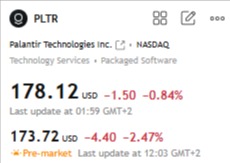When Everyone Wants In: The Hard Truth About Late Entries
Someone asked if it still makes sense to join Palantir now after we had a nice short trade idea on PLTR stock yesterday. That question opens a bigger lesson that applies to every market and every asset: late entries can work, but they demand stricter discipline and, many times, surprising re-entry prices (more distant than you initially imagine or see on your chart).
You see a clean move. You feel the pull to jump aboard. That is exactly when trades become harder. Crowded trades get messy. Market makers shake late entrants. The easy part is often already priced in.
Why late entries are difficult
Crowded trades are hard trades. When many traders try to join, clean fills vanish. Price will often whip around key levels, take obvious stops, and only then move again.
Late shorts become liquidity. A stock that already fell in pre market lures reactive shorts. Smart money often drives price back into their entries to force covers. That buying becomes fuel against you.
Professionals take profits into chasers. Systematic desks scale out near liquidity. If you are buying or selling at those same levels, you are likely providing their exit.
The late entry framework that actually helps
Wait for a trap or retest. Look for a stop sweep, a reclaim or loss of VWAP, a break then a clean retest, a quick fake through a prior high or low. You want others trapped, not yourself.
Demand a fresh signal. Enter only when your timeframe shows new information, not just a big candle. Examples include a decisive reclaim or loss of a key level with immediate follow through and volume, or a clear rejection confirmed by tape and order flow.
Stagger entries. Cast a net at two or three prices clustered around a level that pros care about. Equal size is fine. Do not go all in at one price.
Place a professional stop. Stops sit beyond invalidation with a small buffer. Never on the line. Never beyond the opposite threshold of your plan.
Manage on rails. Take partial profit at the first clean target. Move the stop to entry after TP1 so the remainder is protected. Let statistics and levels, not feelings, decide what stays on.
A word on shorts and time
Over the horizons most people trade, equities tend to rise over time. Shorting can be profitable, but pullbacks against you are often sharper than expected. That is even more reason to demand better entry prices, clearer signals, and disciplined risk control.
Palantir as the live example
Context at publish time: PLTR finished yesterday roughly minus zero point eight percent and is up about three point five percent in pre market today. Today’s intraday VWAP has been acting as resistance near the mid one seventy fours. The goal is not to chase red or green candles. The goal is to sell strength into levels that matter after weaker hands are flushed.
Late entry map for PLTR shorts
Entries focus only. If you choose to trade, adapt the risk settings to your plan.

First sell at 176.03
Rationale: above a VWAP reclaim and near the value area low from October 15 where supply can reappear.Second sell at 178.06
Rationale: deeper into the supply pocket where short covers exhaust.Third sell at 180.33
Rationale: final tier into a higher liquidity shelf.
Equal size across all three entries. If all three fill, the average entry is 178.14.
Now, that 3rd sell order is high, perhaps too high, and is mainly there, in this specific case, as a low probability fill backup. Traders can easily decide, at their discretion to set sell orders at the 2 of the 3 sell orders above. Some would even just join the $176 zone sell and manage their trade from there (power tip for traders: set a price where you would move the stop to the entry)
Suggested invalidation
Place the stop a small buffer above the highest entry. A practical example is above 181.00. This keeps the stop beyond the supply band yet tight enough to keep the plan attractive.
Management suggestion
After your first target is achieved, move the stop on the remainder to your average entry to protect the position. For targets, you can reference yesterday’s investingLive.com PLTR short plan. At minimum, consider using the furthest target from that plan as one of your take profit references. If momentum weakens earlier around intraday supports near the mid one seventies, take a first partial there and let the rest seek the deeper levels only if price continues to confirm.
Why wait this high
You want late shorts to be forced out first. When those covers exhaust, the buy pressure fades, and supply can take over again. Selling into that exhaustion gives you a better location and a cleaner risk reward than chasing weakness.
Important housekeeping
If you use good till canceled orders, review them regularly. If the larger premise changes or your timeframe expires, cancel the orders so you do not get a fill weeks later under a different regime.
Concise answer to the PLTR question
If you want in after yesterday’s small drop and today’s pre market pop, do not chase. Let PLTR reclaim and test above intraday VWAP, then stage equal size sells at 176.03, and 178.06. This is not a full trade idea like yesterday's so setting your stop is up to you. If you want to practice and see ideas around that and more trading elements, you are welcome to join us at https://t.me/investingLiveStocks (it's free).
After your first take profit is hit, move the stop to your average entry and manage the rest toward the deeper targets from the prior trade idea if momentum continues to confirm.
Closing thought
You do not need more trades. You need better trades. Late entries are not forbidden. They are earned. Wait for the trap, demand a fresh signal, scale with intent, and manage by rules. If you are not filled, that is fine. The market will always offer another clean chance.




